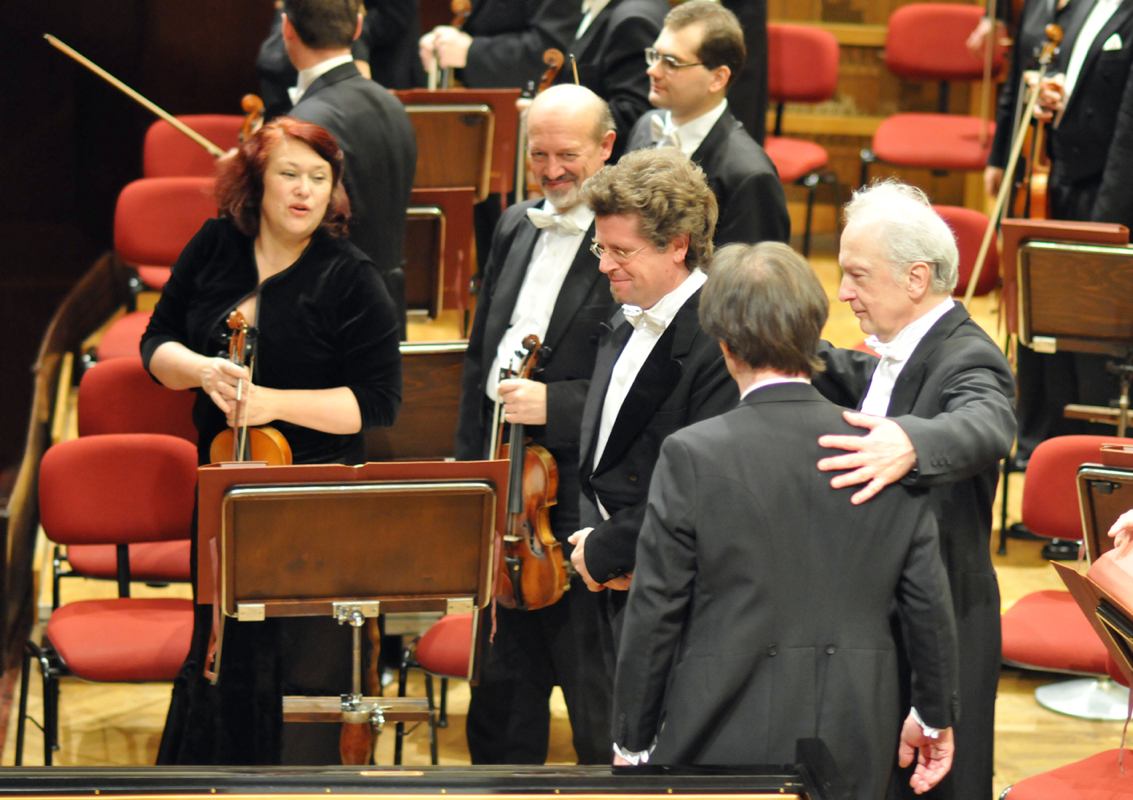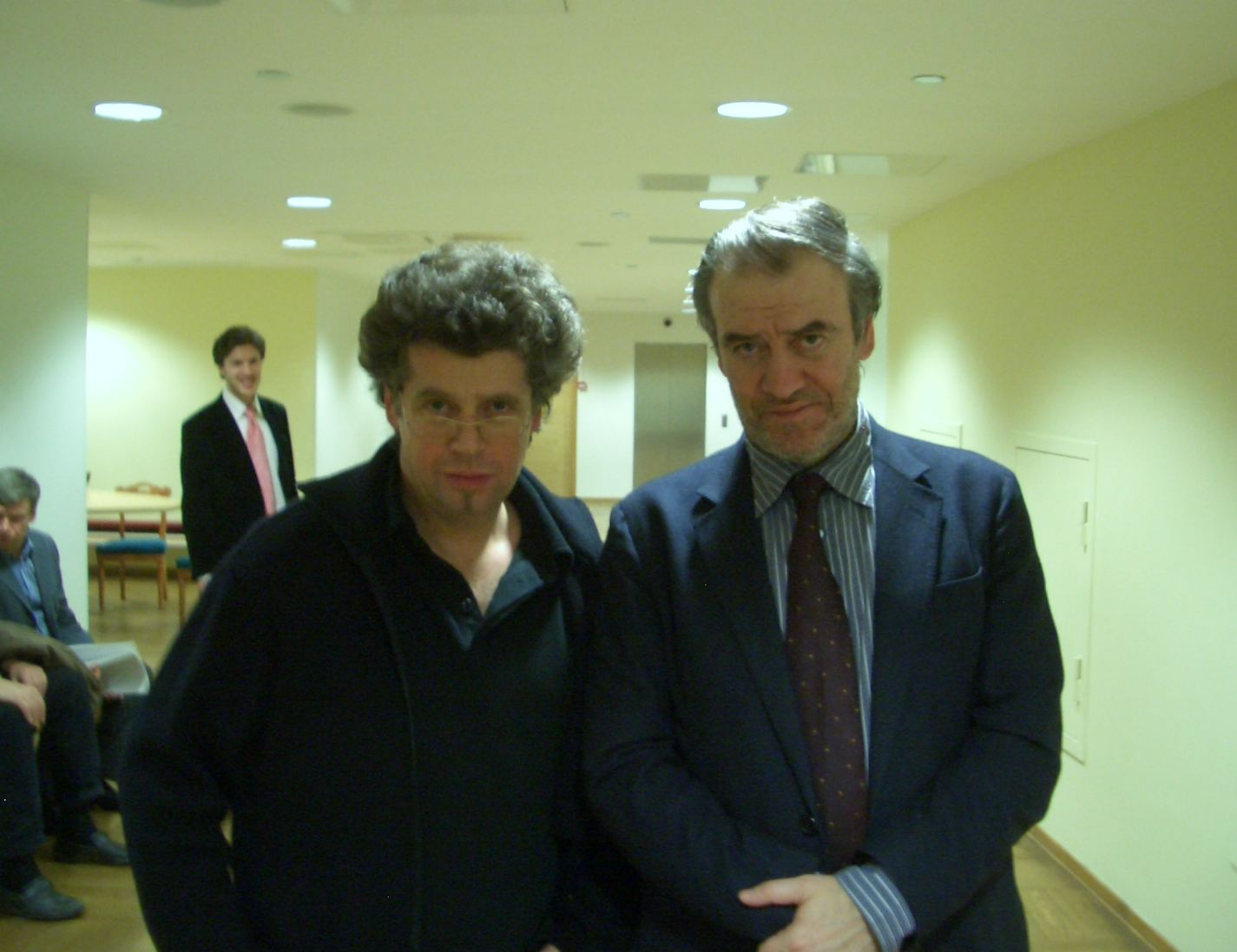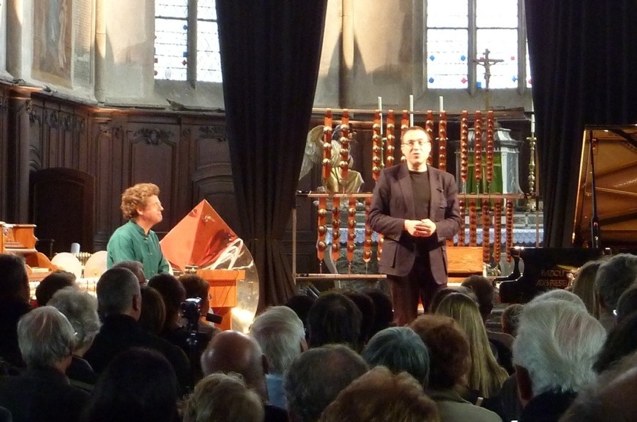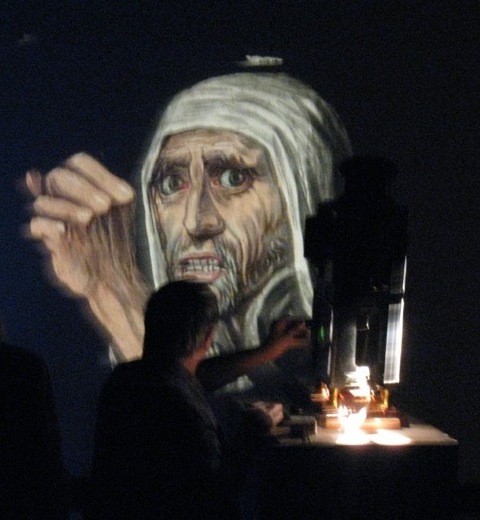THOMAS BLOCH ** ONDES MARTENOT - GLASSHARMONICA - CRISTAL BASCHET -- (original) (raw)
biography
discography
gallery
audio - video
performances
composition
press kit
glass harmonica
ondes martenot
cristal baschet
waterphone
theremin cello
musical saw
crystal voice
studio
links
Recital (details below), orchestra (details below), chamber music (details below), recording sessions, theater music, film music, advertising, pop music, creations, improvisation, songs, ballet music, jazz, rock, world music, concert / lectures in schools, universities and music academies, masterclasses, artistic direction of festivals, Erik Satie's Vexations (a 24 hours’ non-stop performance alone at the piano)...
For any request or further information, please write to Thomas Bloch
RECITAL
RARE INSTRUMENTS
Original works from the 18th century to today with one or several of the rare instruments played solo by Thomas Bloch (glass harmonica, ondes Martenot, crystal Baschet,...) : solo recitals, lectures / concerts, presentation of the instruments in schools, private events for companies... Some recent works may use a playback for pre-recorded electronic parts.
. ORCHESTRA (chamber, sinfonietta, symphony)
SOLOIST - SOLO - TUTTI
Baroque, classical, contemporary repertoires
Creation of new works, baroque and classical repertoires with the 430 Hz glass harmonica or the 442 Hz glass harmonica (Mozart, Beethoven, Hasse, CPE Bach, Donizetti, R. Strauss...) and also 20th and 21st centuries repertoires with ondes Martenot and cristal Baschet (Messiaen, Varese, Honegger, Hindemith, Landowski, Bussotti, Scelci, Greenwood...).
CHAMBER MUSIC
CRYSTAL VOICE and GLASS INSTRUMENTS
A duet unique in the world ! A sopranist (male soprano) and glass instruments : Patrick Husson and Thomas Bloch. The latter can also play the piano or the organ besides his glass instruments in order to extend the repertoire. There are about a dozen male sopranos in the world. They are probably the closest heirs to the castrati and Farinelli. Works from the baroque period to today : Mozart, Pergolesi, Broschi, Monteverdi, Haendel, Verdi, Fauré, Bloch, Gorecki, Gershwin... Some recent works may use a playback for pre-recorded electronic parts.
| Patrick HUSSON male sopranoThomas BLOCH glass armonica, crystal Baschet, possibly keyboard | 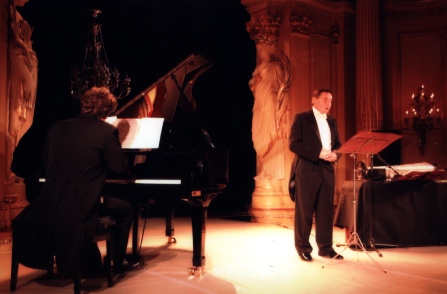 |
|---|
JEAN-FRANC OIS ZYGEL'S WONDERFUL CABARET
Variable-geometry ensemble around Jean-François Zygel, from the Zygel - Bloch duet (piano, celesta, glockenspiel and rare instruments) to a dozen musicians. Many options are offered with other members of the ensemble, among which two bird singers (Jean Boucault and Johnny Rasse), a juggler / dancer (Jive), a percussionist (Joel Grare), a clarinetist (Philippe Berrod), a cellist (Salque François), a snake player (Michel Godard ), a saxophonist (Philippe Geiss), one voice or more (Robert Expert, Isabelle Poinloup, Laurent Alvaro ...), offering a wonderful cabaret, an improvisation concert, accompaniment of silent movies (Nosferatu by Murnau )....
MAGIC LANTERNS / PHANTASMAGORIA and LIGHT PROJECTIONS
It is the only pre-cinema performance in Europe who, by means of a scenario including all the major themes ofPhantasmagoria shows how was its practice in the late 18th century and in the 19th century. The magic lantern (the one used was made in 1880) and moving hand painted glass plates (from the late 18th and 19th centuries) gives life to evil beings who start disturbing the life of a charming little village. Ghosts, witches, devils, the Apocalypse horsemen and the famous blood-covered nun carry us away into the kingdom of darkness and fear. The projections of such films were usually accompanied by the glass harmonica, the nail violin (also called nail Harmonica, an ancestor of the waterphone) and various instruments used for sound illustration. According to Jefferson, "the melodious sounds of Benjamin Franklin's Harmonica contribute powerfully to the effects of phantasmagoria, by preparing not only the minds but all the senses as well for strange impressions".
HARP and GLASS ARMONICA and/or ONDES MARTENOT
A unique duet with a young harpist who is considered as pushing the limits of his instrument, plays along with a cousin of the glass harp. Works from the 18th century to today, solo and duet : Mozart, Beethoven, Wagner / Liszt, Mendelssohn, Brahms, Fauré, Hindemith, Messiaen, Bacri, Hersant, Redolfi ... Some recent works may use electronics. You can choose to hear the classical harp, or the triple harp (barock) - together with the glass harmonica in 430 -, or the celtic harp, or the electro-acoustic harp.
Visit Pauline Haas website here.
| Pauline HAAS harpThomas BLOCH glassharmonicaand/or ondes Martenot | 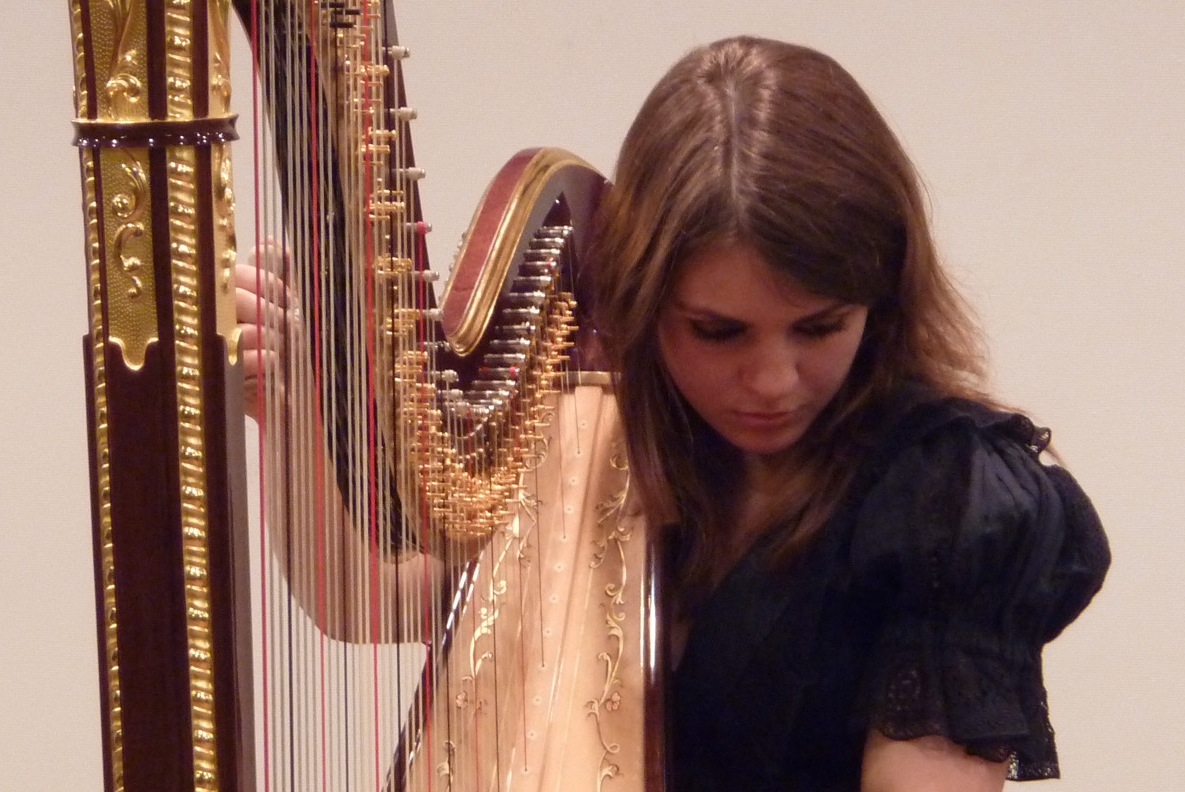 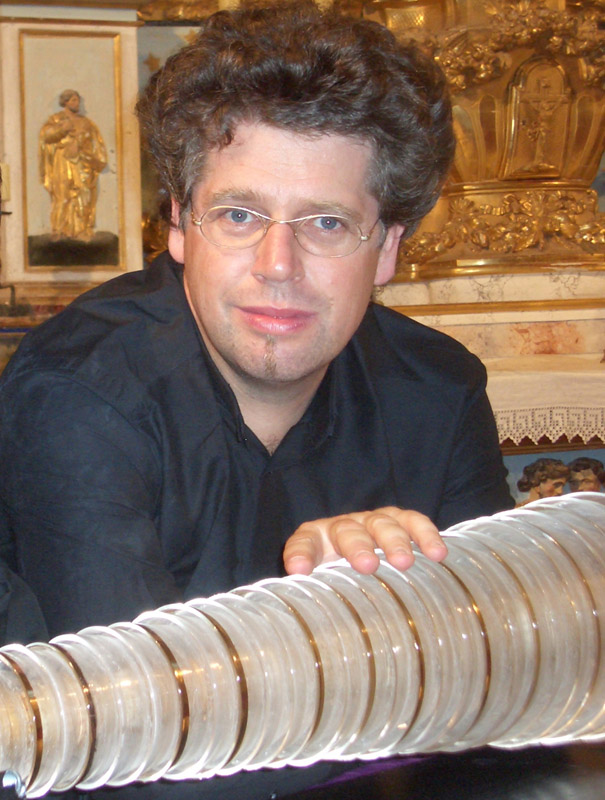 |
|---|
ACCORDION and RARE INSTRUMENTS
A unique duet with the very first laureate of the recent accordion class in Paris Conservatoire National Superieur de Musique. Works from the 18th century to today and to jazz, solo and duets : Mozart, Fauré, Messiaen, Piazzolla, E. Bloch, Rachmaninov, Cavanna, Dubugnon... Some recent works may use a playback for pre-recorded electronic parts.
| Melanie BREGANT accordion Thomas BLOCH ondes Martenot and/or glassharmonica | 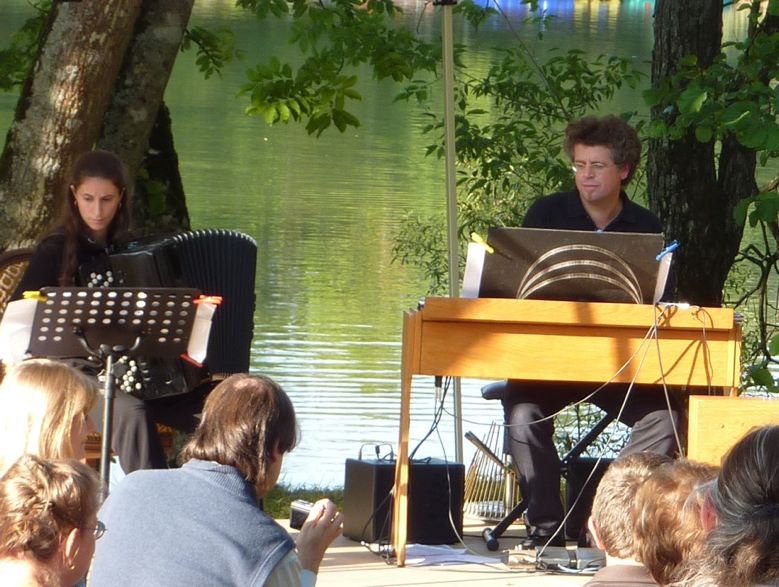 |
|---|
RARE INSTRUMENTS and PIANO
Works from the 18th century to today and jazz, solos and duets. Works for the piano (original works and arrangements of works originally meant for instrumental ensembles) by Mozart, Reichardt, Sombach, Benjamin Franklin, CPE Bach, Fauré, Messiaen, Murail, Wisson, Jolivet, Bloch, improvisations... It is possible to play with a pianist Thomas Bloch generally works with or with a musician you'll choose. Some recent works may use a playback for pre-recorded electronic parts.
| Among possible pianists : Jay GOTTLIEB, François WEIGEL, Bernard WISSON... Thomas BLOCH ondes Martenot and/or glass harmonica | 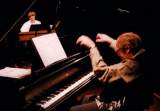 Bernard Wisson (piano) Bernard Wisson (piano) |
|---|
GLASS ORGAN and CHURCH ORGAN and/or ONDES MARTENOT
Paganini named the glass harmonica : "an angel organ". It was also sometimes called glass organ. So, the idea of mixing both kinds of organs seemed an evidence. Mozart, Reichardt, Benjamin Franklin, Hasse, CPE Bach, Mendelssohn, JS Bach ... and also the large repertoires for the organ and for the glassharmonica, each played by itself, in a classical and / or contemporary repertoire. It is also possible to use ondes Martenot with the glass organ or separately. Some recent works may use a playback for pre-recorded electronic parts.
Visit Yves Rechsteiner's website here.
| Yves RECHSTEINER organThomas BLOCH glass organ (glass armonica) and/or ondes Martenot | 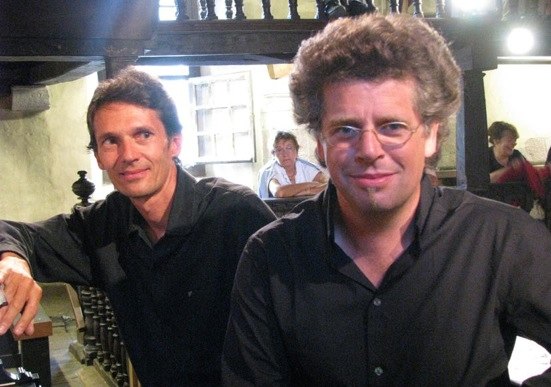 |
|---|
FLUTES and GLASSHARMONICA
Original works from the 18th century to today with the best-known and most inventive Belgian flutist : from Mozart to Piazzolla (who composed his famous Story of the Tango for Marc Grauwels). Some recent works may use a playback for pre-recorded electronic parts.
Visit Marc Grauwels website here.
| Marc GRAUWELS flutesThomas BLOCH glassharmonica | 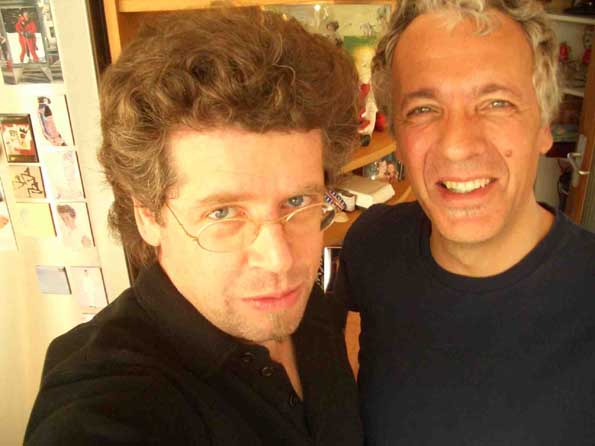 |
|---|
BARYTONE VIOLIN and GLASS ARMONICA
The Barytone-violin sounds very much like the viola and the cello put together. It is even rarer than the glass harmonica. Jacques Dupriez plays the only one known today. It was invented centuries ago and was considered as the ideal instrument and supposed to stand between the viola and cello. Of the viola it has the technique and of the cello the depth and power. Works from the 18th century to today : Mozart, CPE Bach, Espejo, Bloch, Paganini, Bacri... either with gut strings and the 430 Hz armonica to give a baroque identity or with metal strings and the 442Hz armonica. Some recent works may use a playback for pre-recorded electronic parts.
Visit Jacques Dupriez website here.
| Jacques DUPRIEZ barytone-violinThomas BLOCH glass harmonica | 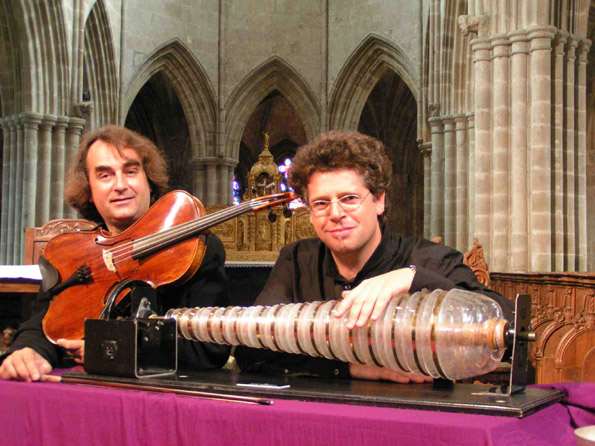 |
|---|
CRYSTAL BASCHET, BARYTONE VIOLIN and GLASS ARMONICA
A unique association of three musicians, each of them considered as the best performer with his own rare instrument(s) . The range of the two glass instruments used here is the same as that of a piano. Works from the 18th century to today : Mozart, Reichardt, Paganini, Deneuve, Bloch, Bacri...Some recent works may use a playback for pre-recorded electronic parts.
Visit Michel Deneuve's website here. Visit Jacques Dupriez website here.
| Michel DENEUVE cristal Baschet Jacques DUPRIEZ barytone violinThomas BLOCH glass armonica | 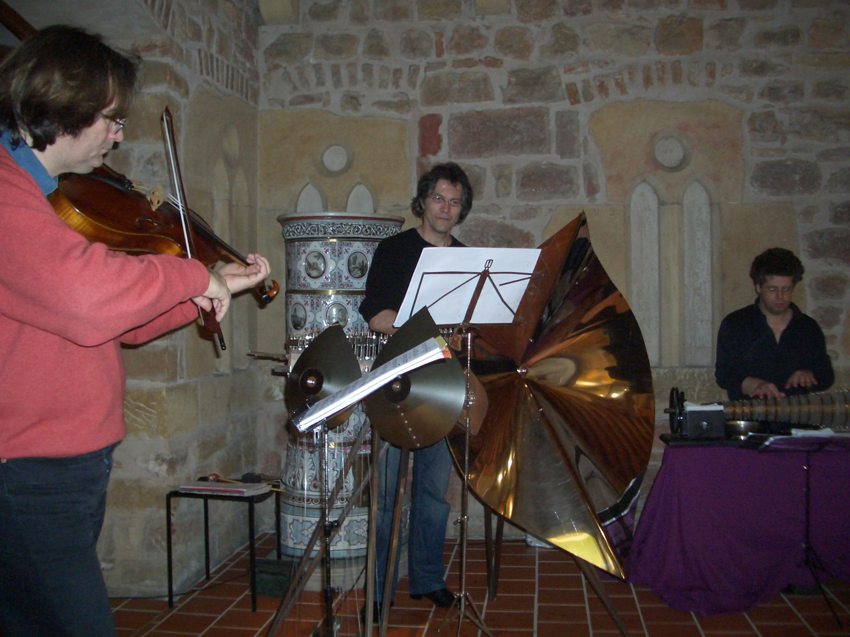 |
|---|
MICHEL REDOLFI - THOMAS BLOCH
Works from the 18th century to today. Most of the recent works have been composed by Michel Redolfi for the rare instruments and live electronics. Staging, sound design and possibly visual design for all sorts of places (concert halls, swimming pools - underwater music - , the sea, outdoor places, churches, streets ...). Michel Redolfi is a composer of electronic music from GRM (Groupe de Recherche Musical founded by Pierre Schaeffer and Pierre Henri). He has done research work at San Diego University (California) and invented the underwater concerts (concerts in a pool with special loudspeakers, the audience being only able to hear the music when they are in the water). He also composed and created soundscapes for the largest aquatic parks and more recently for the new tramcar in Nice (France).
Visit Michel Redolfi's website here.
| Michel REDOLFI composer, sound design, muti tracks mixing, electro-acousticThomas BLOCH rare instruments | 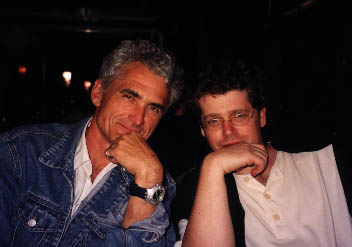 |
|---|
FINE TUNING
Experimental music, contemporary music, improvisation. The trio can be associated with other musicians, voices, dance, painting, literature...Some recent works may use a playback for pre-recorded electronic parts.
| Etienne ROLIN saxophones, flutes, clarinettes, electronic devicesThomas BLOCH rare instrumentsKent CARTER double bass | 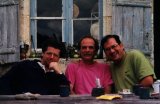 |
|---|
DRAMATIC (not always...) SOPRANO, ONDES MARTENOT, CRISTAL BASCHET, WATERPHONE and PIANO
Eclectic repertoire (from baroque to the cabarets of the 1950ies, concert in F by Gershwin, Fats Waller, Messiaen, Britten, Liszt, Chopin, Rachmaninoff, The Rolling Stones...), improvisations, interactive participation of the public (someone is asked to conduct us, other can propose a thema on which we'll improvise in various styles, etc). Some recent works may use a playback for pre-recorded electronic parts.
To hear and see Isabelle Poinloup here. Visit Francois Weigel's website here.
| Isabelle POINLOUP voice, waterphoneThomas BLOCH rare instrumentsFrançois WEIGEL piano | 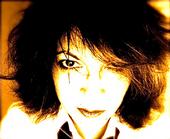 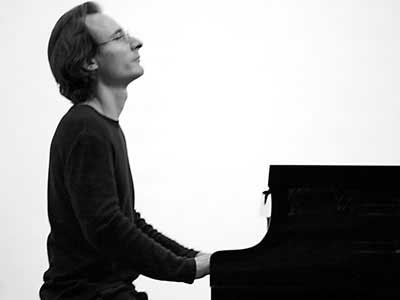 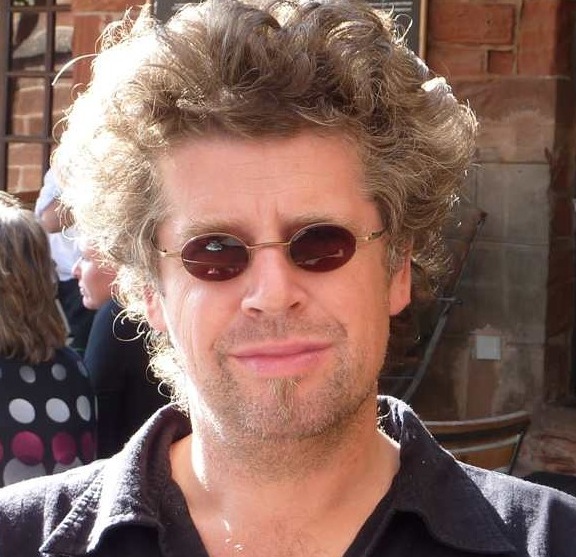 |
|---|
CRYSTAL VOICE, GLASS ARMONICA and QUARTET
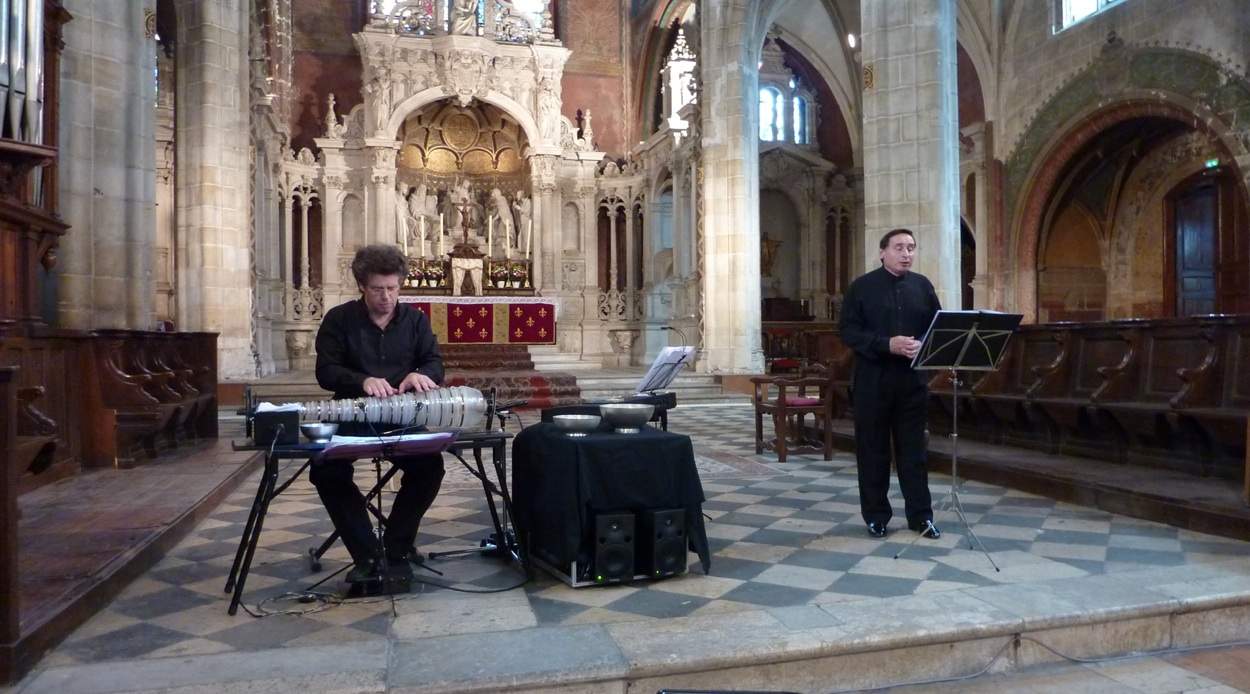 |
A mixture of the repertoires mentioned above - all combinations possible (solos, duets to sextets).Patrick Husson (male soprano), Thomas Bloch (glass harmonica) and either of the quartets they usually play with (several possibilities) or an ensemble of your choice. Some recent works may use a playback for pre-recorded electronic parts. Click here for access to the ensemble webpage |
|---|
QUARTET / QUINTET with GLASSHARMONICA
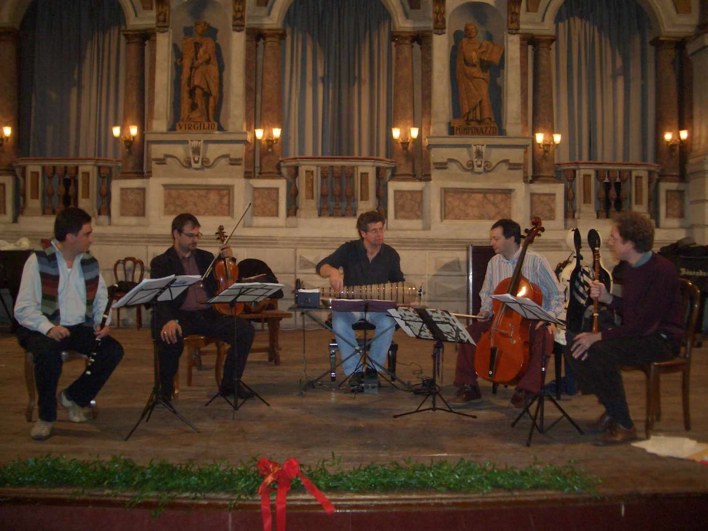 Il Zefiro (Alfredo Bernardini, cond.)and Thomas Bloch in Mantova (Italia) Il Zefiro (Alfredo Bernardini, cond.)and Thomas Bloch in Mantova (Italia) |
From solo performance to a quintet with the glass armonica : Mozart (Adagio und Rondo K.617for glass harmonica, flute, oboe, viola and cello), Reichardt, Benjamin Franklin, Hasse, CPE Bach ... to today’s music and also the large repertoires of the quartet and of the quintet, their choice of instruments and musicians depending on wishes and budgets (strings quartet / flute and strings trio / flute, oboe, viola, cello / flute, oboe, strings trio ...).Thomas Bloch may play with the musicians he usually plays with or with an ensemble of your choice. For ideas, you can refer to his biography, to the section "musical partners", bearing in mind that not all the artists have been mentioned and that there are always many other choices possible. Some recent works may use a playback for pre-recorded electronic parts. |
|---|


